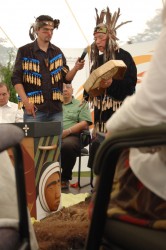Article Origin
Volume
Issue
Year
A box crafted with the pain that one grandmother suffered while attending residential school sat in the centre of the first sharing circle hosted by the Truth and Reconciliation Commission at the TRC’s inaugural national event in Winnipeg June 16 to 19.
When Coast Salish artist Luke Marston started working on the box, he asked his mother to tell him stories about his grandmother’s time at residential school at Kuper Island. B.C. His mother told him that when his grandmother was a young child, she was grabbed by a nun and thrown down the stairs, breaking her fingers. Her hand was never cared for and her fingers healed in “a cramped position.”
“I remember seeing that as a child but I never knew the reason why her hands were like that,” said Marston
On one side of the Bentwood box Marston depicts his grandmother’s experience, her bent fingers and both hands held up in supplication.
“In a way it symbolizes my grandmother. It symbolizes more than just her. It symbolizes all the Elders that lost their children. And were persecuted or arrested for trying to stop the people who came to take their children away,” said Marston.
Marston was commissioned two-and-a half years ago to make the box for the TRC. He was directed to include all Aboriginal peoples — First Nations, Inuit, and Metis — who were impacted by residential schools. The box is made of a single piece of red cedar steamed and bent.
On the panel representing the Inuit people, Marston has included green stripes, indicative of the Northern Lights. He said an Inuit woman told him that the Northern Lights symbolized “ancestors in the sky.”
Stars on one end of the box are a reminder that “we come from the star people,” said Marston.
The panel depicting First Nations people includes a young boy with the traditional haircut and wearing war paint. Cutting of braids and long hair was a common practice at residential schools.
“The war paint symbolizes the strength of youth,” said Marston, who remembered that today’s Elders were yesterday’s children, who were taken away.
The box also includes the Metis symbol.
Along the top of the box are crosses.
Said Marston, “We all know that Christianity led to the movement of the residential schools.”
The Bentwood box will be used to gather the gifts that mark the personal journeys of the survivors. Gifts will be collected as the TRC travels through communities listening to the stories of residential school survivors, said Commission chair Justice Murray Sinclair. Once the box is full, the gifts will be taken to the TRC’s new office in Winnipeg, which includes a room for those gifts.
Among the gifts that were received at the first national event hosted by the TRC were moccasins from Leanne (Crowchief) Sleigh, a member of the Siksika First Nation in Alberta, and a healing quilt from the University of Winnipeg’s Institute for Women’s and Gender Studies.
As she laid her moccasins beside the box, Sleigh said they were “for all those people who walked the path before us.”
- 4455 views

